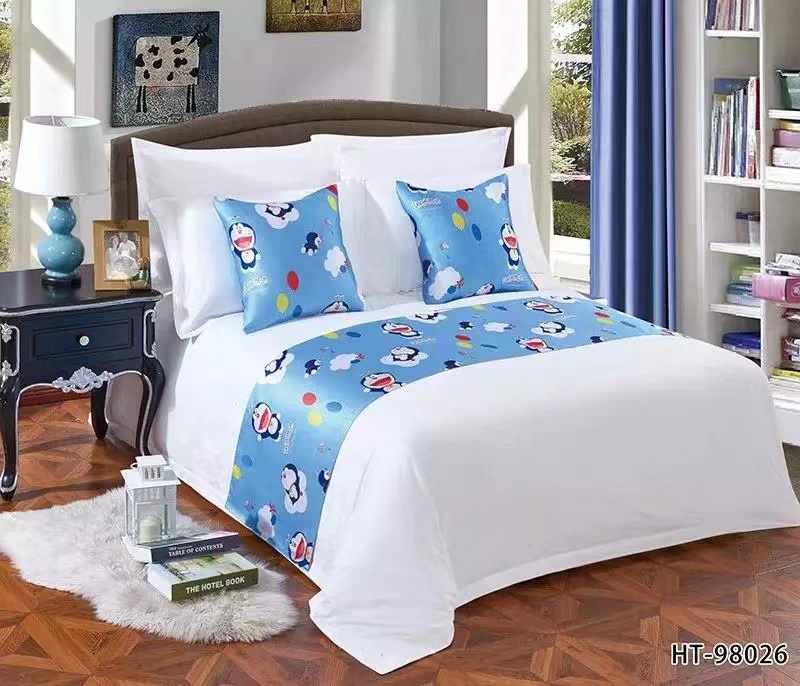不同的纤维及其织物都会存在不同程度的缩水。酒店布草的面料多为纯棉、涤棉和丝绸,这三种材料制成的布草都会存在一定程度的缩水。根据相关的国家标准,缩水率应在3%-4%,但一些质量较差的产品可能会达到8%-10%.
Different fibers and their fabrics will experience varying degrees of shrinkage. The fabric of hotel linen is mostly pure cotton, polyester cotton, and silk, and the linen made of these three materials will have a certain degree of shrinkage. According to relevant national standards, the shrinkage rate should be between 3% -4%, but some products with poor quality may reach 8% -10%
布草中的纤维在制造时,会受到外力作用产生变形,呈现出静态干松弛、静态干松弛、动态湿松弛、全松弛等状态,从而使布草长度变长。布草在洗涤的过程中,再次受到外力作用,打破了以上的状态,恢复至原始的长度。
During the manufacturing process, the fibers in the linen will undergo deformation under external forces, exhibiting states such as static dry relaxation, static dry relaxation, dynamic wet relaxation, and full relaxation, thereby lengthening the length of the linen. During the washing process, the linen was once again subjected to external forces, breaking the above state and restoring its original length.
纺织纤维受热条件下,纤维的形态及尺寸发生变化及收缩,降温后亦不能回复到初始状态,称为纤维热收缩。而热收缩前与热收缩后的长度百分比称为热收缩率,一般以沸水收缩测试,在100℃沸水中,纤维长度收缩的百分率作表示;亦有用热空气方式,在超过100℃的热空气中测其收缩的百分率,亦有用蒸气方式,在超过100℃的蒸气中测其收缩的百分率。纤维因内部结构及受热温度、时间等不同条件下表现亦不同,例如加工涤纶短纤的沸水收缩率为1%,维纶沸水收缩率为5%,氯纶热空气收缩率为50%。纤维在纺织加工及其织物的尺寸稳定性有著密切的关系,为后工序之设计提供一些依据。

Under heating conditions, the shape and size of textile fibers undergo changes and shrinkage, and even after cooling, they cannot return to their initial state, which is called fiber thermal shrinkage. The percentage of length before and after thermal shrinkage is called the thermal shrinkage rate, which is generally expressed as the percentage of fiber length shrinkage in boiling water at 100 ℃; It is also possible to use hot air to measure the percentage of shrinkage in hot air above 100 ℃, or steam to measure the percentage of shrinkage in steam above 100 ℃. The performance of fibers varies under different conditions such as internal structure, heating temperature, and time. For example, the boiling water shrinkage of processed polyester staple fibers is 1%, the boiling water shrinkage of vinylon is 5%, and the hot air shrinkage of chloroprene is 50%. There is a close relationship between fibers in textile processing and the dimensional stability of their fabrics, providing some basis for the design of subsequent processes.
缩水率的影响因素
Factors affecting shrinkage rate
布草的面料不同,缩水率也有所不同。吸湿性大的纤维,浸水后纤维膨胀,直径增大,长度缩短,缩水率就大。如有的粘胶纤维吸水率高达13%,而合成纤维织物吸湿性差,其缩水率就小。
The shrinkage rate of linen varies depending on the fabric. Fibers with high hygroscopicity expand, increase in diameter, shorten in length, and increase in shrinkage after immersion in water. If some viscose fibers have a water absorption rate of up to 13%, while synthetic fiber fabrics have poor moisture absorption, their shrinkage rate is small.
布草纱支粗细不同,缩水率也不同。纱支的粗细会影响纤维在水中的大小,从而影响布草的缩水率。一般来说,纱支粗的布缩水率就大,纱支细的织物缩水率就小。
The shrinkage rate of linen yarn varies depending on the thickness of the yarn. The thickness of the yarn count will affect the size of the fibers in water, thereby affecting the shrinkage rate of the linen. Generally speaking, fabrics with coarse yarn count have a higher shrinkage rate, while fabrics with fine yarn count have a lower shrinkage rate.
织物的密度不同,缩水率也不同。 如经纬向密度相近,其经纬向缩水率也接近。经密度大的织品,经向缩水就大,反之,纬密大于经密的织品,纬向缩水也就大。一般情况下,高密度织物的尺寸稳定性要优于低密度的。
The density of the fabric varies, and the shrinkage rate also varies. If the density in the longitude and latitude directions is similar, the shrinkage rate in the longitude and latitude directions is also similar. A fabric with high warp density will experience greater warp shrinkage, while a fabric with higher weft density than warp density will experience greater warp shrinkage. In general, the dimensional stability of high-density fabrics is better than that of low-density fabrics.
织物生产工艺不同,缩水率也不同。 一般来说,织物在织造和染整过程中,纤维要拉伸多次,加工时间长,施加张力较大的织物缩水率就大,反之就小。为了控制布料的门幅,在实际工艺中,我们一般用预缩水来解决这个问题。
The shrinkage rate varies depending on the production process of the fabric. Generally speaking, during the weaving and dyeing and finishing process of fabrics, the fibers need to be stretched multiple times, and the processing time is long. The shrinkage rate of fabrics with higher applied tension is higher, and vice versa. In order to control the width of the fabric, in actual processes, we usually use pre shrinkage to solve this problem.

